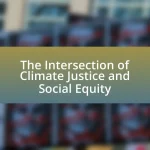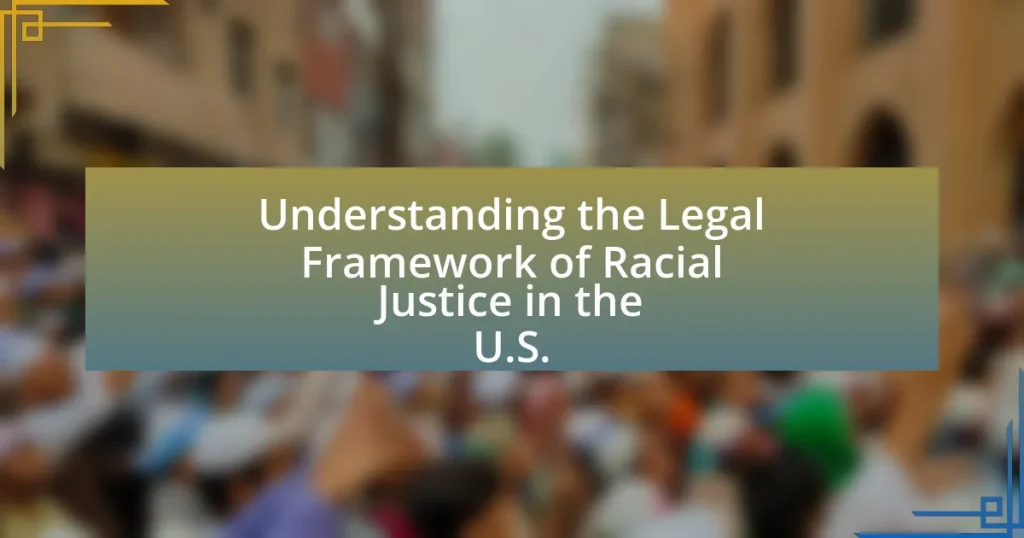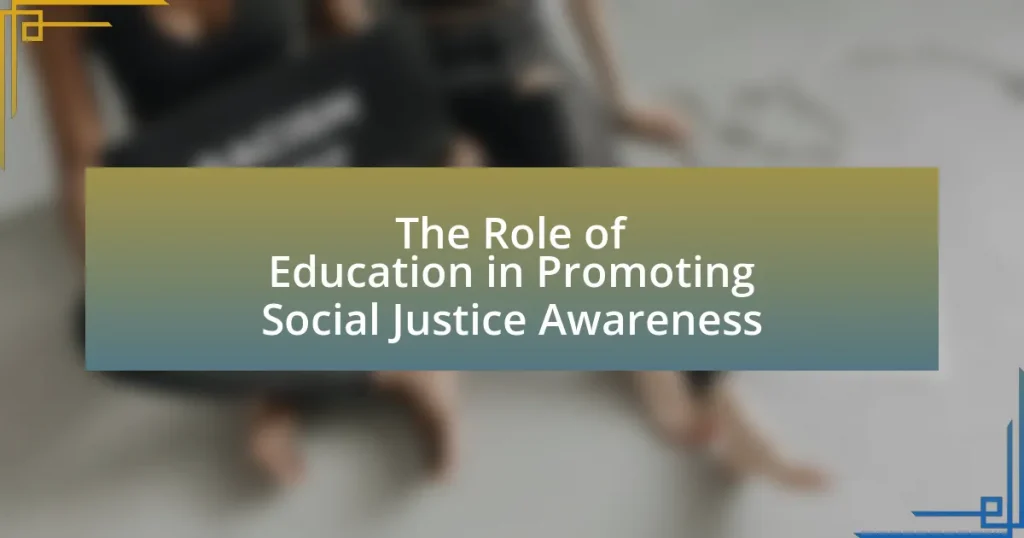The article examines the intersection of climate justice and social equity, highlighting how marginalized communities disproportionately suffer from the impacts of climate change and environmental degradation. It emphasizes the need for equitable distribution of environmental benefits and burdens, advocating for the inclusion of social equity in climate policies to address systemic inequalities. Key principles of climate justice, such as equity, participation, and accountability, are discussed alongside the fundamental aspects of social equity, including fairness and access to resources. The article also explores the challenges and barriers faced in achieving these goals, the role of policy decisions, and practical solutions to promote both climate justice and social equity.
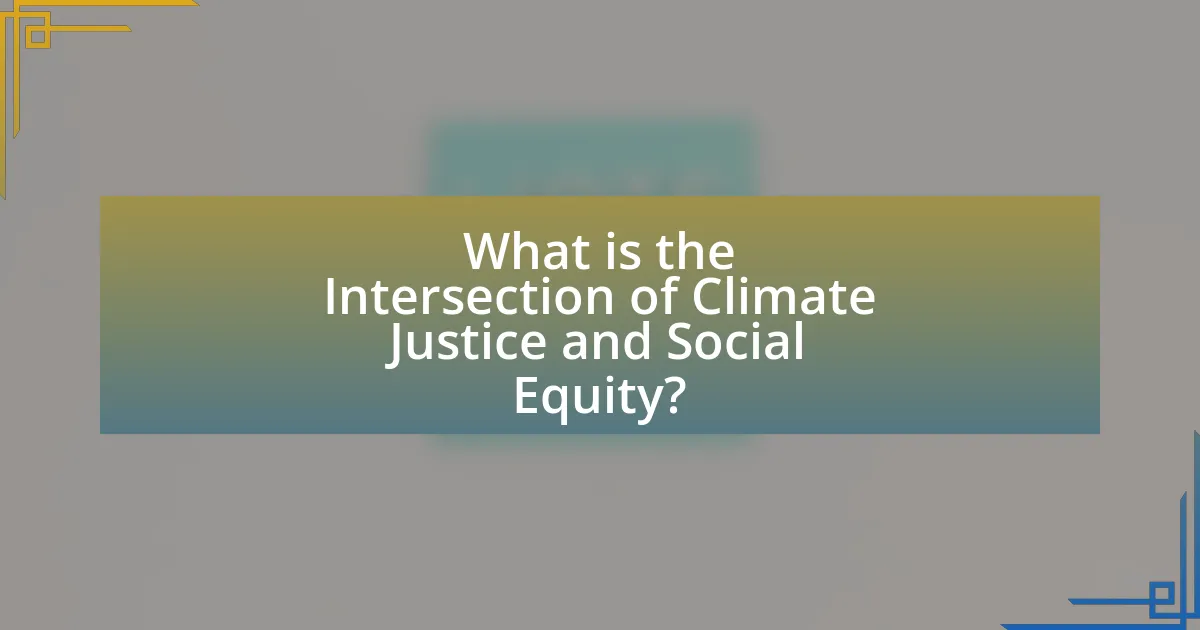
What is the Intersection of Climate Justice and Social Equity?
The intersection of climate justice and social equity refers to the recognition that marginalized communities disproportionately experience the impacts of climate change and environmental degradation. Climate justice advocates for the fair distribution of environmental benefits and burdens, emphasizing that social equity must be integrated into climate policies to address systemic inequalities. For instance, studies show that low-income and minority populations are more likely to live in areas vulnerable to climate-related disasters, such as flooding and heatwaves, highlighting the need for inclusive decision-making processes that prioritize these communities.
How do climate justice and social equity relate to each other?
Climate justice and social equity are interconnected concepts that address the disproportionate impacts of climate change on marginalized communities. Climate justice emphasizes the need for fair treatment and meaningful involvement of all people in environmental decision-making, recognizing that low-income and minority groups often bear the brunt of climate-related disasters and policies. Social equity, on the other hand, focuses on ensuring that all individuals have equal access to resources, opportunities, and rights, which includes addressing systemic inequalities that exacerbate vulnerability to climate change. Research shows that communities of color and low-income populations are more likely to experience adverse effects from climate change, such as increased flooding and heatwaves, highlighting the necessity of integrating social equity into climate justice initiatives to create sustainable and inclusive solutions.
What are the key principles of climate justice?
The key principles of climate justice include equity, participation, and accountability. Equity emphasizes the fair distribution of environmental benefits and burdens, recognizing that marginalized communities often face the greatest impacts of climate change. Participation involves ensuring that all stakeholders, particularly those affected by climate policies, have a voice in decision-making processes. Accountability requires that governments and corporations are held responsible for their actions and commitments related to climate change. These principles are supported by the recognition that climate change disproportionately affects vulnerable populations, as highlighted in reports from organizations like the Intergovernmental Panel on Climate Change, which detail the social and economic disparities exacerbated by environmental degradation.
What are the fundamental aspects of social equity?
The fundamental aspects of social equity include fairness, access, and participation in societal resources and opportunities. Fairness ensures that individuals receive what they need to thrive, which may involve addressing historical injustices and systemic inequalities. Access refers to the ability of all individuals to obtain essential services, such as education, healthcare, and employment, regardless of their background. Participation emphasizes the importance of including diverse voices in decision-making processes, particularly those from marginalized communities. These aspects are critical in promoting a just society where everyone has the opportunity to succeed and contribute.
Why is the intersection of these concepts important?
The intersection of climate justice and social equity is important because it addresses the disproportionate impacts of climate change on marginalized communities. Research indicates that low-income and minority populations often bear the brunt of environmental degradation and climate-related disasters, which exacerbates existing social inequalities. For instance, a study by the National Academy of Sciences found that communities of color are more likely to live in areas with higher pollution levels, leading to increased health risks. By integrating climate justice with social equity, policies can be designed to ensure that vulnerable populations receive the support needed to adapt to climate change, thereby promoting fairness and resilience in society.
How does climate change disproportionately affect marginalized communities?
Climate change disproportionately affects marginalized communities by exacerbating existing social and economic inequalities. These communities often lack the resources to adapt to climate impacts, such as extreme weather events, rising sea levels, and food insecurity. For instance, a report by the National Oceanic and Atmospheric Administration indicates that low-income neighborhoods are more likely to experience flooding and heatwaves, leading to health risks and economic losses. Additionally, marginalized groups frequently reside in areas with less infrastructure and fewer services, making recovery from climate-related disasters more challenging. This systemic vulnerability highlights the urgent need for equitable climate policies that address these disparities.
What role does social equity play in addressing climate change impacts?
Social equity plays a crucial role in addressing climate change impacts by ensuring that vulnerable populations receive fair treatment and access to resources needed for adaptation and mitigation. This principle recognizes that marginalized communities often bear the brunt of climate-related disasters, such as floods and heatwaves, due to systemic inequalities. For instance, a report by the Intergovernmental Panel on Climate Change (IPCC) highlights that low-income and minority groups are disproportionately affected by climate change, facing higher risks and fewer resources to cope with its effects. By prioritizing social equity, policies can be designed to empower these communities, enhance their resilience, and promote inclusive decision-making processes that consider the needs of all stakeholders.
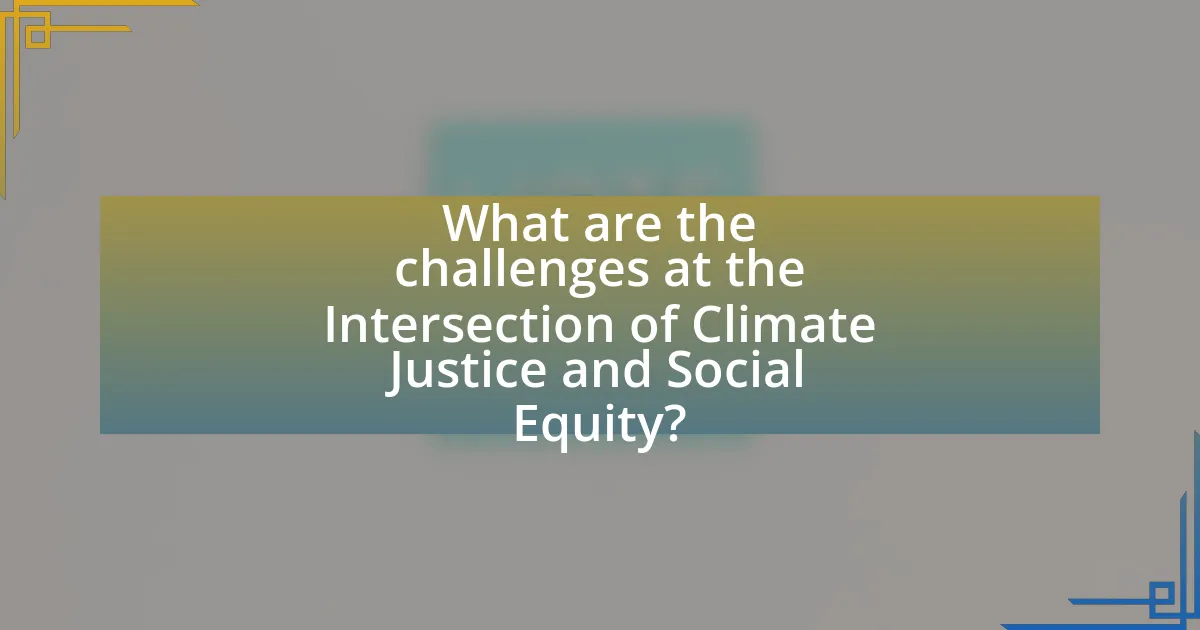
What are the challenges at the Intersection of Climate Justice and Social Equity?
The challenges at the intersection of climate justice and social equity include systemic inequality, inadequate representation, and disproportionate impacts of climate change on marginalized communities. Systemic inequality manifests in the unequal distribution of resources and opportunities, which hinders vulnerable populations from accessing climate adaptation and mitigation strategies. Inadequate representation in decision-making processes leads to policies that do not reflect the needs of affected communities, further exacerbating social inequities. Additionally, marginalized groups often face the brunt of climate-related disasters, such as flooding and heatwaves, due to their socioeconomic status, which limits their resilience and recovery capabilities. For instance, studies show that low-income neighborhoods are more likely to be located in flood-prone areas, highlighting the intersection of environmental hazards and social vulnerability.
What barriers exist in achieving climate justice and social equity?
Barriers to achieving climate justice and social equity include systemic inequality, lack of political will, and insufficient access to resources. Systemic inequality manifests in the disproportionate impact of climate change on marginalized communities, which often lack the political power to influence decision-making processes. For instance, studies show that low-income neighborhoods are more likely to be located near polluting industries, exacerbating health disparities. Additionally, the lack of political will is evident in the slow implementation of policies that address climate change and social inequities, as seen in the delayed responses to climate crises in vulnerable regions. Furthermore, insufficient access to resources, such as funding for sustainable development and education, hinders communities from adapting to climate impacts and achieving equity. These barriers collectively impede progress toward a just and equitable response to climate change.
How do systemic inequalities hinder progress?
Systemic inequalities hinder progress by creating barriers that limit access to resources, opportunities, and decision-making power for marginalized groups. These inequalities manifest in various forms, such as economic disparities, racial discrimination, and unequal access to education and healthcare. For instance, a report from the United Nations highlights that marginalized communities often bear the brunt of climate change impacts due to their lack of resources to adapt or recover, which perpetuates cycles of poverty and vulnerability. Consequently, systemic inequalities not only impede individual advancement but also stifle collective societal progress by preventing diverse perspectives and solutions from contributing to critical issues like climate justice.
What are the economic challenges faced by vulnerable populations?
Vulnerable populations face significant economic challenges, including limited access to quality employment, inadequate financial resources, and heightened exposure to economic shocks. These groups often experience higher unemployment rates, with the International Labour Organization reporting that youth and marginalized communities are disproportionately affected. Additionally, they frequently lack access to affordable housing and healthcare, which exacerbates their financial instability. Economic disparities are further intensified by systemic barriers such as discrimination and lack of educational opportunities, leading to a cycle of poverty that is difficult to escape.
How do policy decisions impact this intersection?
Policy decisions significantly impact the intersection of climate justice and social equity by shaping regulations that determine resource allocation, environmental protections, and community resilience. For instance, policies that prioritize renewable energy investments can reduce greenhouse gas emissions while simultaneously creating jobs in underserved communities, thereby promoting social equity. Research from the National Academy of Sciences indicates that equitable climate policies can lead to a 30% reduction in energy costs for low-income households, demonstrating the tangible benefits of integrating social equity into climate action. Furthermore, policies that enforce stricter pollution controls in marginalized neighborhoods can improve public health outcomes, illustrating how targeted policy decisions can address both environmental and social injustices.
What are the implications of environmental policies on social equity?
Environmental policies significantly impact social equity by influencing access to resources, health outcomes, and economic opportunities. For instance, policies aimed at reducing pollution often prioritize marginalized communities that are disproportionately affected by environmental hazards, thereby promoting equity. Research indicates that areas with stringent environmental regulations experience improved public health outcomes, which benefits low-income populations who typically face higher health risks due to environmental degradation. Furthermore, equitable access to green spaces and clean energy initiatives can enhance quality of life and economic prospects for disadvantaged groups, as evidenced by studies showing that investments in renewable energy create jobs in underserved areas. Thus, effective environmental policies can serve as tools for advancing social equity by addressing systemic inequalities and fostering inclusive growth.
How can policies be designed to promote both climate justice and social equity?
Policies can be designed to promote both climate justice and social equity by integrating community input, prioritizing vulnerable populations, and ensuring equitable distribution of resources. Engaging marginalized communities in the policy-making process allows for the identification of specific needs and challenges they face, which can lead to more effective climate solutions. For instance, the Green New Deal in the United States emphasizes job creation in renewable energy sectors for disadvantaged communities, aiming to address both environmental and economic inequalities. Furthermore, studies show that policies that allocate funding for climate adaptation projects in low-income neighborhoods can significantly reduce vulnerability to climate impacts, thereby promoting social equity while addressing climate justice.
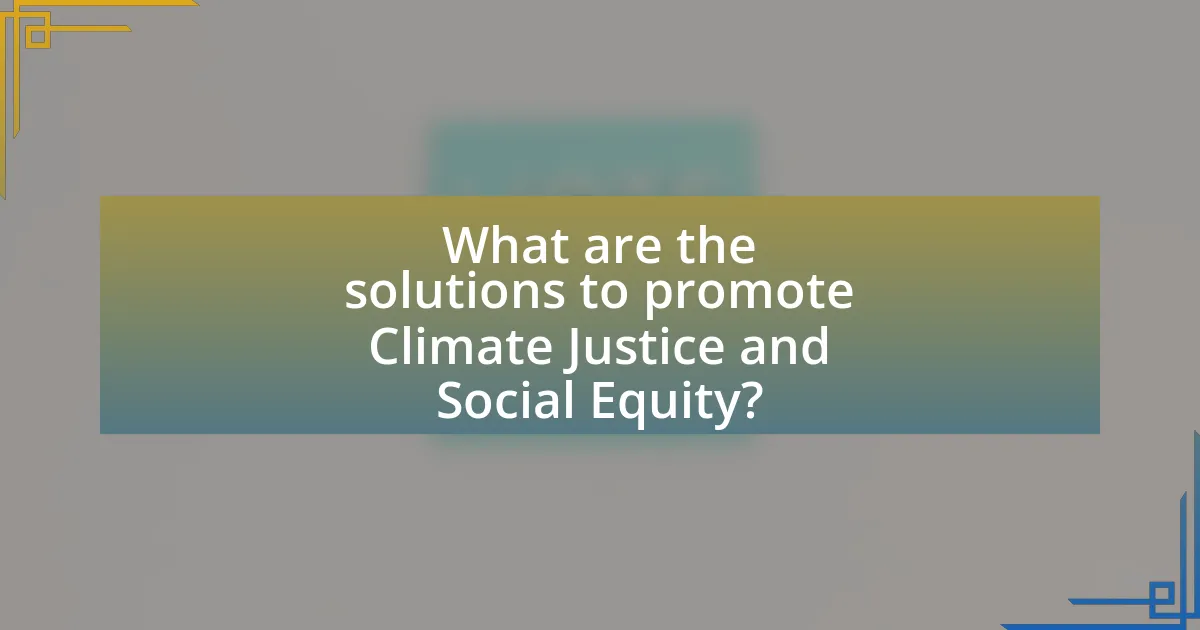
What are the solutions to promote Climate Justice and Social Equity?
Solutions to promote Climate Justice and Social Equity include implementing policies that ensure equitable access to resources and decision-making processes for marginalized communities. These policies can be supported by frameworks such as the Green New Deal, which aims to create jobs in renewable energy sectors while prioritizing disadvantaged groups. Additionally, investing in community-led initiatives that focus on sustainable practices can empower local populations and address historical injustices. Research indicates that inclusive climate action not only mitigates environmental impacts but also fosters social cohesion and economic resilience, as seen in studies by the United Nations Development Programme, which highlight the importance of integrating social equity into climate strategies.
What strategies can be implemented to address these issues?
To address the issues at the intersection of climate justice and social equity, implementing community-based adaptation strategies is essential. These strategies involve engaging local communities in decision-making processes to ensure that their specific needs and vulnerabilities are addressed. For instance, the United Nations Framework Convention on Climate Change emphasizes the importance of participatory approaches, which have been shown to enhance resilience and empower marginalized groups. Additionally, integrating social equity into climate policies, such as equitable access to renewable energy resources and financial support for low-income households, can mitigate the disproportionate impacts of climate change on vulnerable populations. Research by the World Resources Institute indicates that inclusive climate action not only improves environmental outcomes but also fosters social cohesion and economic opportunities for disadvantaged communities.
How can community engagement enhance climate justice efforts?
Community engagement enhances climate justice efforts by fostering inclusive decision-making processes that reflect the needs and voices of marginalized communities. When communities actively participate in climate initiatives, they can identify specific local vulnerabilities and advocate for equitable resource distribution. Research indicates that inclusive engagement leads to more effective climate policies; for instance, a study by the National Academy of Sciences found that community-driven approaches improve resilience and adaptation strategies, particularly in low-income areas disproportionately affected by climate change. This collaborative approach not only empowers communities but also ensures that climate justice efforts address systemic inequalities, ultimately leading to more sustainable and equitable outcomes.
What role do grassroots movements play in promoting social equity?
Grassroots movements play a crucial role in promoting social equity by mobilizing communities to advocate for their rights and address systemic inequalities. These movements empower marginalized groups, enabling them to voice their concerns and influence policy changes that directly affect their lives. For instance, the Civil Rights Movement in the United States successfully challenged racial discrimination and led to significant legislative reforms, such as the Civil Rights Act of 1964. Additionally, grassroots organizations often focus on local issues, fostering community engagement and solidarity, which are essential for achieving equitable outcomes. Research indicates that grassroots activism can lead to increased political participation and greater awareness of social justice issues, further reinforcing the importance of these movements in the pursuit of social equity.
What best practices can be adopted for effective implementation?
Effective implementation of climate justice and social equity initiatives can be achieved through community engagement, policy integration, and continuous evaluation. Community engagement ensures that the voices of marginalized groups are included in decision-making processes, fostering trust and collaboration. Policy integration involves aligning climate policies with social equity goals, ensuring that initiatives address both environmental and social issues simultaneously. Continuous evaluation allows for the assessment of progress and the adaptation of strategies based on feedback and outcomes. Research indicates that participatory approaches lead to more equitable and sustainable outcomes, as seen in the 2020 report by the United Nations Development Programme, which highlights the importance of inclusive governance in achieving sustainable development goals.
How can organizations collaborate to foster climate justice and social equity?
Organizations can collaborate to foster climate justice and social equity by forming partnerships that prioritize marginalized communities in climate action initiatives. Collaborative efforts can include joint advocacy for equitable policies, sharing resources and knowledge, and engaging in community-based projects that address both environmental and social issues. For example, the Climate Justice Alliance, which consists of various organizations, emphasizes the importance of grassroots leadership and equitable resource distribution to ensure that vulnerable populations are not disproportionately affected by climate change. This approach is supported by research indicating that inclusive decision-making processes lead to more effective and just climate solutions.
What are the key indicators of success in these initiatives?
Key indicators of success in initiatives at the intersection of climate justice and social equity include measurable improvements in community resilience, equitable access to resources, and reductions in greenhouse gas emissions. Community resilience can be assessed through metrics such as the ability to withstand climate-related events, which is often evaluated by the number of community-led adaptation projects implemented. Equitable access to resources is indicated by the percentage of marginalized populations benefiting from renewable energy programs or green job training initiatives, with successful programs often showing at least a 30% increase in participation from these groups. Reductions in greenhouse gas emissions can be quantified through baseline and follow-up assessments, with successful initiatives typically achieving a minimum of 20% reduction over a specified period. These indicators collectively demonstrate the effectiveness of initiatives in promoting both climate justice and social equity.
What practical steps can individuals take to support this intersection?
Individuals can support the intersection of climate justice and social equity by actively participating in community initiatives that promote sustainable practices and equitable resource distribution. Engaging in local environmental organizations, advocating for policies that address both climate change and social inequalities, and supporting businesses that prioritize sustainability and fair labor practices are effective actions. Research indicates that communities with strong social equity frameworks are better equipped to adapt to climate impacts, as seen in studies by the United Nations Environment Programme, which highlight the importance of inclusive decision-making in climate resilience efforts.



